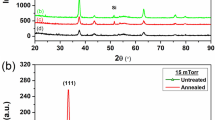Abstract
Ta/NiO x /Ni81Fe19/Ta multilayers were prepared by rf reactive and dc magnetron sputtering. The exchange coupling field (H ex) and the coercivity (H c) of NiO x /Ni81Fe19 as a function of the ratio of Ar to O2 during the deposition process were studied. The composition and chemical states at the interface region of NiO x /NiFe were also investigated using the X-ray photoelectron spectroscopy (XPS) and peak decomposition technique. The results show that the ratio of Ar to O2 has great effect on the nickel chemical states in NiO x film. When the ratio of Ar to O2 is equal to 7 and the argon sputtering pressure is 0.57 Pa, the x value is approximately 1 and the valence of nickel is +2. At this point, NiO x is antiferromagnetic NiO and the corresponding H ex is the largest. As the ratio of Ar/O2 deviates from 7, the exchange coupling field (H ex) will decrease due to the presence of magnetic impurities such as Ni+3 or metallic Ni at the interface region of NiO x /NiFe, while the coercivity (H c) will increase due to the metallic Ni. XPS studies also show that there are two thermodynamically favorable reactions at the NiO/NiFe interface: NiO+Fe=Ni+FeO and 3NiO+2Fe=3Ni+Fe2O3. These interface reaction products are magnetic impurities at the interface region of NiO/NiFe. It is believed that these magnetic impurities would have effect on the exchange coupling field (H ex) and the coercivity (H c) of NiO/NiFe.
Similar content being viewed by others
References
Dieny, B. J., Giant magnetoresistance in spin-valve multilayers, Magn. Magn. Mater., 1994, 136: 335–359.
Meiklejohn, W. H., Bean, C. P., New magnetic anisotropy, Phys. Rev. B, 1956, 102: 1423–1428.
Malozemoff, A. P., Random-field model of exchange anisotropy at rough ferromagnetic-antiferromagnetic interfaces, Phys. Rev. B, 1987, 35: 3679–3682.
Mauri, D., Kay, E., Scholl, D., et al., Simple model for thin ferromagnetic films exchange coupled to an antiferromagnetic substrate, J. Appl. Phys., 1987, 62: 3047–3050.
Koon, N. C., Calculations of exchange bias in thin films with ferromagnetic/antiferromagnetic interface, Phys. Rev. Lett., 1997, 78(25): 4865–4868.
Hong, T. M., Consequences of spin-flop coupling in exchange biased films, Phys. Rev. B., 1998, 58: 97–100.
Hwang, D. G., Lee, S. S., Park, C. M., Effect of roughness slope on exchange biasing in NiO spin valves, Appl. Phys. Lett., 1998, 72 (17): 2162–2164.
Shen, J. X., Kief, M. T., Exchange coupling between NiO and NiFe thin films, J. Appl. Phys., 1996, 79(8): 5008–5010.
Michel, R. P., Chaiken, A., Kim, Y. K. et al., NiO exchange bias layers grown by direct ion beam sputtering of a nickel oxide target, IEEE Trans. Magn., 1996, 32: 4651–4653.
Shang, C. H., Berera, G. P., Moodera, J. S., Exchange-biased ferromagnetic tunnel junctions via reactive evaporation of nickel oxide films, Appl. Phys. Lett., 1998, 72: 605–607.
Wagner, C. D., Riggs, W. M., Davis, L. E. et al., Handbook of X-ray photoelectron spectroscopy, U.S.A., Perkin-Elmer, 1979, 76, 80.
Atanassova, E., Dimitrova, T., Koprinarova, J., AES and XPS study of thin RF-sputtered Ta2O5 layers, Appl. Surf. Sci., 1995, 84: 193–202.
Tanuma, S., Powell, C. J., Penn, D. R., Calculations of electron inelastic mean free paths for 31 materials, Surf. Interface Anal., 1988, 11: 577–589.
Kubaschewski, O., Alcock, C. B., Spencer, P. J., Materials Thermochemistrys, New York: Pergamon Press, 1993, 278, 300.
Kools, J. C. S., Effect of energetic particle bombardment during sputter deposition on the properties of exchange-biased spinvalve multilayers, J. Appl. Phys., 1995, 77: 2993–2998.
Author information
Authors and Affiliations
Corresponding author
Rights and permissions
About this article
Cite this article
Yu, G., Chai, C., Zhu, F. et al. Interface chemical states of NiO/NiFe films and their effects on magnetic properties. Sci. China Ser. E-Technol. Sci. 45, 27–34 (2002). https://doi.org/10.1360/02ye9004
Received:
Issue Date:
DOI: https://doi.org/10.1360/02ye9004




